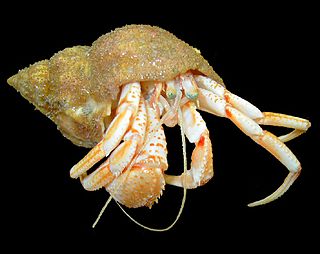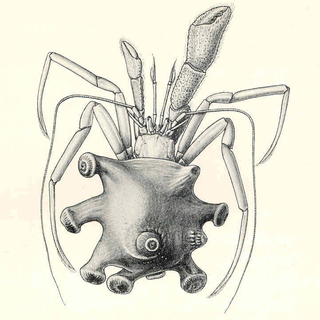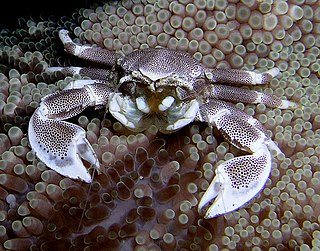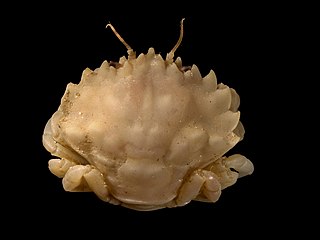
Axius is a genus of mud lobster containing the following species:

The Diogenidae are a family of hermit crabs, sometimes known as "left-handed hermit crabs" because in contrast to most other hermit crabs, its left chela (claw) is enlarged instead of the right. It comprises 429 extant species, and a further 46 extinct species, making it the second-largest family of marine hermit crabs, after the Paguridae.

The Paguridae are a family of hermit crabs of the order Decapoda. The king crabs, Lithodidae, are now widely understood to be derived from deep within the Paguridae, with some authors placing their ancestors within the genus Pagurus.

Dromiidae is a family of crabs, often referred to as sponge crabs. They are small or medium-sized crabs which get their name from the ability to shape a living sponge into a portable shelter for themselves. A sponge crab cuts out a fragment from a sponge and trims it to its own shape using its claws. The last two pairs of legs are shorter than other legs and bend upward over the crab's carapace, to hold the sponge in place. The sponge grows along with the crab, providing a consistent shelter.

The Parapaguridae are a family of marine hermit crabs from deep waters. Instead of carrying empty gastropod shells like other hermit crabs, they carry colonies of dozen or more sea anemones or zoanthids. Some genera, such as Bivalvopagurus and Tylaspis, do not inhabit shells. The following genera are included:
Etyiidae is a prehistoric family of dromiacean crabs only known from Cretaceous and a few Paleocene fossils.

The Maastricht Formation, named after the city of Maastricht in the Netherlands, is a geological formation in the Netherlands and Belgium whose strata date back to the Late Cretaceous, within 500,000 years of the Cretaceous–Paleogene boundary, now dated at 66 million years ago. The formation is part of the Chalk Group and is between 30 and 90 metres thick. It crops out in southern parts of Dutch and Belgian Limburg and adjacent areas in Germany. It can be found in the subsurface of northern Belgium and southeastern Netherlands, especially in the Campine Basin and Roer Valley Graben. Dinosaur remains are among the fossils that have been recovered from the formation.

Cirolanidae is a family of aquatic isopods.
The Tielt Formation is a geologic formation in the subsurface of Belgium. The formation crops out in the north of Hainaut, in the southern and central parts of West- and East Flanders and in Walloon and Flemish Brabant. It consists of marine very fine sand and silt, deposited in the shallow sea that covered Belgium during the middle and late Ypresian age.

Albuneidae is a little-known family of specialized burrowing sand crabs. There are 50 extant species as well as nine fossil species that have been described. Fossil specimens have been described from the Cretaceous, Miocene and Oligocene.

Albunea is a genus of mole crab within the Albuneidae. Little is known about this group's biology. A. groeningi is named after Matt Groening, creator of The Simpsons.

Corystidae is a family of crabs, in its own superfamily, Corystoidea. It includes what was once thought to be the oldest Eubrachyuran fossil, Hebertides jurassica, thought to be dating from the Bathonian ; the species was subsequently reinterpreted as being Cenozoic in age. Corystidae contains ten extant and five extinct species in eight genera:

Ciliopagurus is a genus of hermit crabs, of the family Diogenidae, which are sometimes referred to as the "left-handed hermit crabs", because in contrast to most other hermit crabs, the left chela (claw) is enlarged instead of the right. They are found in the Indo-Pacific region and in the eastern Atlantic Ocean.

The Galatheoidea are a superfamily of decapod crustaceans comprising the porcelain crabs and some squat lobsters. Squat lobsters within the three families of the superfamily Chirostyloidea are not closely related to the squat lobsters within the Galatheoidea. The fossil record of the superfamily extends back to the Middle Jurassic genus Palaeomunidopsis.

Cyclida is an extinct order of crab-like fossil arthropods that lived from the Carboniferous to the Jurassic and possibly Cretaceous. Their classification is uncertain, but they are generally interpreted as crustaceans, likely belonging to the superclass Multicrustacea.
Mesoparapylocheles is an extinct hermit crab genus which existed during the Mesozoic in what is now Europe. It was described by René H.B. Fraaije, Adiël A. Klompmaker and Pedro Artal in 2012. The type species is Mesoparapylocheles michaeljacksoni from the Albian or Cenomanian of Spain; which was named after the singer Michael Jackson. Genus also includes other species from the Late Jurassic (Kimmeridgian) of Germany and from the Late Jurassic (Tithonian) of Austria.
This list of fossil arthropods described in 2012 is a list of new taxa of trilobites, fossil insects, crustaceans, arachnids and other fossil arthropods of every kind that have been described during the year 2012. The list only includes taxa at the level of genus or species.

Necrocarcinidae is an extinct family of Late Jurassic and Cretaceous crabs. It comprises 40 species grouped in seven genera.

Pirimelinae is a subfamily of crabs belonging to the family Carcinidae in the order Decapoda. It previously was treated as a family.

Xylopaguridae are a family of hermit crabs of the order Decapoda. It was erected in 2016 to accommodate one new genus, Prexylopagurus, and three existing genera that had previously been placed in Paguridae. They occur in the Atlantic, Indian, and Pacific Oceans.















